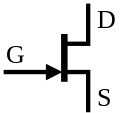Complementary feedback pair
In electronics, the complementary feedback pair, also known as a Sziklai pair, is a configuration of two bipolar transistors, similar to a Darlington pair.[1] In contrast to the Darlington arrangement, the complementary feedback pair has one NPN and one PNP transistor, and so it is sometimes also called the "complementary Darlington". The configuration is named for its early popularizer, George C. Sziklai.

Characteristics
The current gain of the pair is similar to that of a Darlington pair and is the product of the current gains of the two transistors. The figure at the right illustrates an NPN-PNP pair that acts like a single NPN transistor overall. By replacing Q1 with a PNP transistor and Q2 with an NPN transistor the pair will act like a PNP transistor overall.
Applications
In a typical application the complementary feedback pair acts somewhat like a single transistor with the same type (e.g. NPN) as Q1 and with a very high current gain (β). The emitter of Q2 acts the role of a collector. Hence the emitter of Q2 is labeled "C" in the figure to the right. Likewise, in a typical application the collector of Q2 (also connected to the emitter of Q1) plays the role of an emitter and is thus labeled "E." As with a Darlington pair, a resistor (e.g., 100Ω–1kΩ) can be connected between Q2's emitter and base to improve its turn-off time (i.e., its performance for high frequency signals).[1]
Advantages
One advantage over the Darlington pair is that the base turn-on voltage is only about 0.6V or half of the Darlington's 1.2V nominal turn-on voltage. Like the Darlington, it can saturate only to 0.6V, which is a drawback for high-power stages.
Complementary feedback-based output stages
Complementary feedback pairs are often used in the output stages of power amplifiers due to their advantages both in linearity and bandwidth when compared with more common Darlington emitter follower output stages. They are especially advantageous in amplifiers where the intended load does not require the use of parallel devices.[2]
Complementary feedback pairs can also have the benefit of superior thermal stability under the right conditions. In contrast to the traditional Darlington configuration, quiescent current is much more stable with respect to changes in the temperature of the higher power output transistors vs the lower power drivers.[3] This means that a Sziklai output stage in a class AB amplifier requires only that the bias servo transistor or diodes be thermally matched to the lower power driver transistors; they need not (and should not) be placed on the main heatsink. This potentially simplifies the design and implementation of a stable class AB amplifier, reducing the need for emitter resistors,[4] significantly reducing the number of components which must be in thermal contact with the heatsink and reducing the likelihood of thermal runaway.
Optimal quiescent current in an amplifier using complementary feedback pairs also tends to be much lower than in Darlington-based output stages, on the order of 10mA vs. 100mA or more for some emitter follower output stages. This means that idle power consumption is on the order of a few watts versus tens of watts for the same performance in many cases.[2] This is a very compelling reason to use the Sziklai pair in cases where output power is moderate (25-100W), fidelity is critical and relatively low idle power consumption is desired.
Quasi-complementary output stages
Historically, designers frequently used the "quasi-complementary" configuration, which uses a Darlington push pair (i.e., two NPN transistors) and a complementary feedback pull pair (i.e., one PNP and one NPN transistor). This configuration, which uses three NPN transistors and one PNP transistor, is advantageous because while the first transistors and the most common small signal transistors for decades were PNP germanium devices, silicon PNP power transistors were slower to develop, and have historically been more expensive, than their NPN counterparts. Alternately, if a germanium PNP device were used, it would have significantly different characteristics. In the quasi-complementary topology, the performance of the lower pull pair, which used a single NPN transistor, more closely matched the performance of the upper push pair, which consists of two NPN transistors and an identical power device.[3]
While for decades the quasi-complementary output stage made sense, since PNP and NPN power transistors became roughly equally available and had more closely matched performance characteristics, modern audio power amplifiers often use equivalent topologies for both pairs; either both Darlington emitter follower or both Sziklai pair.[3][4]
References
- Horowitz, Paul; Winfield Hill (1989). The Art of Electronics. Cambridge University Press. ISBN 0-521-37095-7.
- Self, Douglas (2013-06-18). Audio Power Amplifier Design (6 ed.). Focal Press. ISBN 9780240526133.
- Products, Rod Elliott - Elliott Sound. "Compound vs Darlington". sound.whsites.net. Retrieved 2016-09-14.
- Elliott, Rod. "High Quality 60 Watt Power Amplifier". sound.whsites.net. Retrieved 2016-09-14.
External links
- U.S. Patent 2,966,632 Multistage semi-conductor signal translating circuits. G.C.Sziklai, December 27, 1960
- U.S. Patent 2,762,870 Push-pull complementary type transistor amplifier. G.C.Sziklai, September 11, 1956
- U.S. Patent 2,791,644 Push-pull amplifier with complementary type transistors. G.C.Sziklai, May 7, 1957
- ECE 327: Procedures for Output Filtering Lab — Section 4 ("Power Amplifier") discusses design of a BJT-Sziklai-pair-based class-AB current driver in detail.

.svg.png)